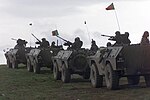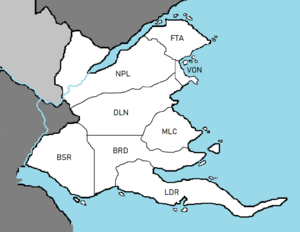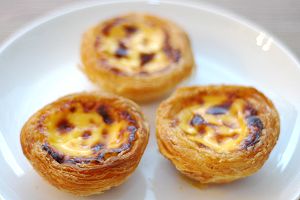Quetana: Difference between revisions
| Line 234: | Line 234: | ||
[[Category:Coalition of Crown Albatross]] | [[Category:Coalition of Crown Albatross]] | ||
[[Category:Zamastan]] | [[Category:Zamastan]] | ||
[[Category:Quetana]] | |||
Revision as of 21:27, 19 October 2020
Quetanan Republic | |
|---|---|
|
Flag | |
 | |
| Capital | Vongane |
| Official languages | Qoati, Caticeze-English |
| Recognised national languages | Qoati |
| Demonym(s) | Quetanan |
| Government | Unitary semi-presidential constitutional republic |
| António Brafeo | |
| José dos Reis | |
| Establishment | |
• Foundation | 868 |
• Republic | 1910 |
| Population | |
• Estimate | 7,400,000 |
| Currency | Quentanan Lien |
| Date format | mm-dd-yyyy |
| Driving side | right |
Quetana, also known as the Quetanan Republic is a moderately sized nation in the Coalition of Crown Albatross, located on a peninsula in Eastern Adula bordering Raviannas to the north, Skith and Andaluni to the west, and an eastern maritime border with Zamastan separated by the Strait of Quetana, which connects the Olympic Ocean and the Toyana Ocean as one of the busiest natural waterways on Iearth. Quetana is one of the oldest nations on Iearth, its territory having been continuously settled, invaded and fought over since prehistoric times. Founded in 868, the County of Quetana gained prominence after the Battle of São Warena (1128). The Kingdom of Quetana was later proclaimed following the Battle of Terrace (1139) and the Treaty of Zamora in 1143.
In the 15th and 16th centuries, Quetana established one of the first global empires, becoming one of the world's major economic, political and military powers. During this period, Quetanan explorers pioneered maritime exploration, notably under royal patronage with such notable voyages as Almirian Gamor discovering the southern-most continent of Antartique. During this time Quentana attemped to monopolize the spice trade and divided the world into hemispheres of dominion. However, events such as the 1724 Vongane earthquake, Skithan Imperial Occupation, the independence of Zamastan (1804) and its subsequent regional rise to power, a late industrialization compared to other Euronian and Adulan powers, a revolution in 1910, and economic turmoil following the World War erased to a great extent Quetana's prior opulence.
Quetana has left a profound cultural, architectural and linguistic influence across the globe, specifically Eastern Adula and Western Euronia, with a legacy of around 250 million Quetanan-based speakers and creoles. It is a developed country with an advanced economy and high living standards. Additionally, it is highly placed in rankings of moral freedom, peacefulness, LGBTI rights, democracy, press freedom, stability, social progress, prosperity, and HDI.
Etymology
The title Quetana historically comes from the family name of Almirs Da Quetan, the King of a Western region kingdom who conquered and named a unified County Quetana in 868 AD. The name gained prominence significantly following the Battle of São Warena (1128). The Kingdom of Quetana was later proclaimed following the Battle of Terrace (1139) and the Treaty of Zamora in 1143. Though the exact meaning of the surname Quetana is unknown, it is believed to have meant "Man of Luck" in ancient Qoati.
History
Modern Day
Quetana joined the Coalition of Crown Albatross upon its founding in 1975, becoming one of the first 15 nations to join.
Quetana faced a severe economic crisis in 2018, which was spurred by unsustainable growth in government debt. This led the country to negotiate in 2019 with the government of Zamastan and the Coalition of Crown Albatross a loan to help the country stabilize its finances.
Geography
The territory of Quetana includes an area on the Quetanan Peninsula (referred to as the continent by most Quetanans) and two archipelagos in the Olympic Ocean: the archipelagos of Dridiera and the Mazores. Mainland Quetana is split by its main river, the Qagus, that flows from Lake Nora as the border between Skith and Andaluni and disgorges in the Qagus Estuary, in Vongane, before escaping into the Olympic Ocean. The northern landscape is mountainous from the coast towards the interior with several plateaus indented by river valleys, whereas the south is characterized by rolling plains.
Quetana's highest peak is Mount Finogal, which measures 2,351 m (7,713 ft). It serves as an important seasonal attraction for skiers and winter sports enthusiasts. The archipelagos of Drideira and the Mazores are scattered within the Olympic Ocean. Geologically, these islands were formed by volcanic and seismic events. The last terrestrial volcanic eruption occurred in 1957–58 and minor earthquakes occur sporadically, usually of low intensity. Quetana's exclusive economic zone, a sea zone over which the Quetanans have special rights over the exploration and use of marine resources, has 1,727,408 km2. This is the 4th-largest exclusive economic zone on the continent of Adula (after Vitosium, Cadair, and Emmiria) and the 20th largest in the world.
Climate
Quetana is defined as a Mediterranean-Equatorial climate, and is a relatively cool temperature compared to other equatorial-tropic Adulan countries: the annual average temperature in mainland Quetana varies from 8–12 °C (46.4–53.6 °F) in the mountainous interior north to 16–20 °C (60.8–68.0 °F) in the south and on the Qagus river basin. There are however, variations from the highlands to the lowlands. Annual average rainfall in the mainland varies from just over 3,200 mm (126.0 in) on the Qwerês National Park. Mount Finogal is recognized as receiving the largest annual rainfall (over 6,250 mm (246.1 in) per year) in Quetana.
Snowfalls occur occassionally in the winter in the interior North of the country, particularly on the mountains. In winter temperatures may drop below −10.0 °C (14.0 °F) in interior mountainous towns. In these places snow can fall any time from October to May. In the South of the country snowfalls are rare but still occur in the highest elevations.
Quetana has around 2300 to 3200 hours of sunshine a year, an average of 4–6 h in winter and 10–12 h in the summer, with higher values in the south-east and lower in the north-west. The average sea surface temperature on the east coast of mainland Quetana varies from 14–16 °C (57.2–60.8 °F) in winter to 19–21 °C (66.2–69.8 °F) in the summer while on the south coast it ranges from 16 °C (60.8 °F) in winter and rises in the summer to about 22–23 °C (71.6–73.4 °F), occasionally reaching 26 °C (78.8 °F).
Government
Quetana has been a semi-presidential representative democratic republic since the ratification of the Constitution of 1911, with Vongane, the nation's largest city, as its capital. The Constitution grants the division or separation of powers among four bodies referred as "organs of Sovereignty": the President of the Republic, the Government, the Assembly of the Republic and the Courts.
The President, who is elected to a five-year term, has an executive role: President is currently António Brafeo. The Assembly of the Republic is a single chamber parliament composed of 230 deputies elected for a four-year term. The Government is headed by the Prime Minister is currently José dos Reis and includes Ministers and Secretaries of State. The Courts are organized into several levels, among the judicial, administrative and fiscal branches. The Supreme Courts are institutions of last resort/appeal. A thirteen-member Constitutional Court oversees the constitutionality of the laws.
Quetana operates a multi-party system of competitive legislatures/local administrative governments at the national, regional and local levels. The Assembly of the Republic, Regional Assemblies and local municipalities and parishes, are dominated by two political parties, the Socialist Party and the Social Democratic Party, in addition to the Unitary Democratic Coalition (Quetanan Communist Party and Ecologist Party "The Greens"), the Left Bloc and the Democratic and Social Center – People's Party, which garner between 5 and 15% of the vote regularly.
Administrative divisions
| Province | Postal abbrev. |
Capital | Population |
|---|---|---|---|
| Vongane | VON | Vongane | 505,526 |
| Brandao | BRD | Baleicos | 894,474 |
| Malacian | MLC | Malcanes | 1,024,933 |
| Leduaranor | LDR | Ledua | 735,067 |
| Basaaria | BSR | Bassari | 688,603 |
| Napilui | NPL | Napani | 809,400 |
| Fatana | FTA | Fiutania | 1,128,465 |
| Dellenao | DLN | Albate | 1,613,532 |
Foreign Relations and Military
 Quetanan Army Chaimite V-200 |
 Quetanan Navy QEKO-200 PN |
 Quetanan Air Force Z-14 Fighter Jet |
Quetana joined the Coalition of Crown Albatross upon its founding in 1975, becoming one of the first 15 nations to join. It has on numerous occassions committed soliders to international peacekeeping campaigns under the C.C.A.'s conduct. Quetana's closest ally is Zamastan, with whom they share 40% of total imports and 56% of total exports. Other close allies are Skith, Rio Palito, Ruskayn, and Caspia. Quetana is part of the Western Euronia Defense Alliance, which is a mutual defense treaty involving several nations in Western Euronia and Eastern Adula.
Major adversaries to the Quetanan government historically has been Emmiria, although the later half of the 20th century and the 21st century thus far have seen the two nations restoring diplomatic connections and increasing bilateral trade agreements.
The Armed Forces of Quetana have three branches: Navy, Army and Air Force. They serve primarily as a self-defense force whose mission is to protect the territorial integrity of the country and provide humanitarian assistance and security at home and abroad. As of 2018, the three branches numbered 39,200 active personnel including 7,500 women. Quetanan military expenditure in 2009 was 5 billion Z$, representing 2.1 per cent of GDP. Military conscription was abolished in 2004. The minimum age for voluntary recruitment is 18 years.
The Army (21,000 personnel) comprises three brigades and other small units. An infantry brigade, a mechanized brigade and a Rapid Reaction Brigade (consisting of paratroopers, commandos and rangers). The Navy (10,700 personnel, of which 1,580 are marines), the world's oldest surviving naval force, has five frigates, seven corvettes, two submarines, and 28 patrol and auxiliary vessels. The Air Force (7,500 personnel) has the Zamastanian Z-14 fighter jet as the main combat aircraft.
Zamastan maintains a military presence with 770 troops in the R'qajes Air Base in the capital of Vongane.
Demographics
Language
Qoati is the official language of Quetana. Qoati is a Romance language that originated from Mulfulira-Qoati; an extinct language that was spoken in what is now Mulfulira and Northern Quetanan regions. There are still many similarities between the Mulfuliran and Quetanan cultures.
Religion
According to the 2019 Census, 81.0% of the Quetanan population is Verdusan Catholic Christian. The country has small Protestant, Latter-day Saint, Muslim, Hindu, Sikh, Eastern Orthodox Church, Jehovah's Witnesses, Baha'i, Buddhist, Jewish and Spiritist communities. Some 6.8% of the population declared themselves to be non-religious, and 8.3% did not give any answer about their religion.
Many Quetanan holidays, festivals and traditions have a Christian origin or connotation. Although relations between the Quetanan state and the Verdusan Catholic Church were generally amiable and stable since the earliest years of the Quetanan nation, their relative power fluctuated. In the 13th and 14th centuries, the church enjoyed both riches and power stemming from its role in the reconquest, its close identification with early Quetanan nationalism and the foundation of the Quetanan educational system, including its first university.
The growth of the Quetanan overseas empire made its missionaries important agents of colonization, with important roles in the education and evangelization of people from all the inhabited continents. The growth of liberal and nascent republican movements during the eras leading to the formation of the First Quetanan Republic (1911–26) changed the role and importance of organized religion. Quentana is a secular state: church and state were formally separated during the Quetanan First Republic, and later reiterated in the 1912 Quentana Constitution.
Culture
Cuisine
Quetanan cuisine is very diverse. The Quetanan people consume a lot of dry cod, for which there are hundreds of recipes. Two other popular fish recipes are grilled sardines and caldeirada, a tomato-based stew that can be made from several types of fish with a mix of onion, garlic, peppers, potatoes, tomatoes, parsley or coriander. Typical Quetanan meat recipes made out of beef, pork, lamb, goat or chicken include cozido à quetaneze, feijoada, frango de churrasco, leitão (roast suckling pig), chanfana and carne de porco à alentejana. A very popular northern dish is dobrada, a tripe with white beans and carrots stew, often served with steamed white rice. Peri-peri chicken is a spicy charcoal chicken dish served with rice and vegetables, a favorite throughout Quetana, but most common in the Malgarve region.
The Quetanan art of pastry has its origins in the many medieval Catholic monasteries spread widely across the country. These monasteries, using very few ingredients (mostly almonds, vanilla, cinnamon, flour, eggs and some liquor), managed to create a spectacular wide range of different pastries, of which pastéis de Belém (or pastéis de nata) originally from Vongagne, and ovos moles from Maveiro are examples. Quetanan cuisine is very diverse, with different regions having their own traditional dishes. The Quetanans have a culture of good food, and throughout the country there are myriads of good restaurants and typical small tasquinhas.
Quetana wines have enjoyed international recognition since the times of the Emmiria Empire, who associated Quetana with wine. Today, the country is known by wine lovers and its wines have won several international prizes. Some of the best Quetana wines are Vinho Verde, Vinho Alvarinho, Vinho do Douro, and the sweet Port Wine.
Economy
Quetana is a developed and a high-income country, with a GDP per capita of 77% of the Eastern Adulan average in 2017 (increasing from 75% in 2012) and a HDI of 0.843 in 2016. By the end of 2018, Quetana's GDP (PPP) was $32,554 per capita, according to C.C.A. Economic Council's report. The national currency of Quetana is the lein, which replaced the Zamastanian dollar, and the country was one of the original member states of the Eastern Adulan Economic Council. Quetana's central bank is the Banco de Quetana, an integral part of the Adulan System of Central Banks. Most industries, businesses and financial institutions are concentrated in the Vongane and Baleicos metropolitan areas.
Quetana has long tried to adapt to a changing modern global economy, a process that continues in 2013. Since the 1990s, Quetana's public consumption-based economic development model has been slowly changing to a system that is focused on exports, private investment and the development of the high-tech sector. Consequently, business services have overtaken more traditional industries such as textiles, clothing, footwear and cork (Quetana is the world's leading cork producer), wood products and beverages.
The banking and insurance sectors performed well until the financial crisis of 2018, and this partly reflected a rapid deepening of the market in Quetana. While sensitive to various types of market and underwriting risks, it has been estimated that overall both the life and non-life sectors will be able to withstand a number of severe shocks, even though the impact on individual insurers varies widely. The "PoverTea" Protests that began in Zamastan in 2018 and 2019 extended to Quetana, resulting in the resignation of several high profile banking executives and government figures.
Travel and tourism continue to be extremely important for Quetana. It has been necessary for the country to focus upon its niche attractions, such as health, nature and rural tourism, to stay ahead of its competitors. Industry is diversified, ranging from automotive, aerospace, electronics and textiles, to food, chemicals, cement and wood pulp. Agriculture and forestry industries also exist, though the country largely operates in regards to importing agricultural products from Zamastan and Mulfulira since the turn of the millenium. Traditionally a sea power, Quetana has had a strong tradition in the Quetanan fishing sector and is one of the countries with the highest fish consumption per capita.






